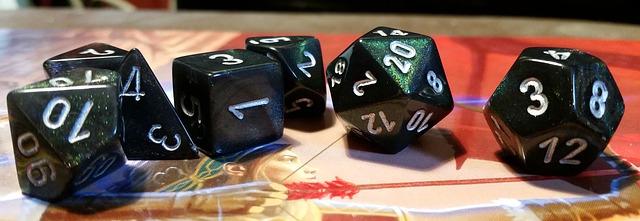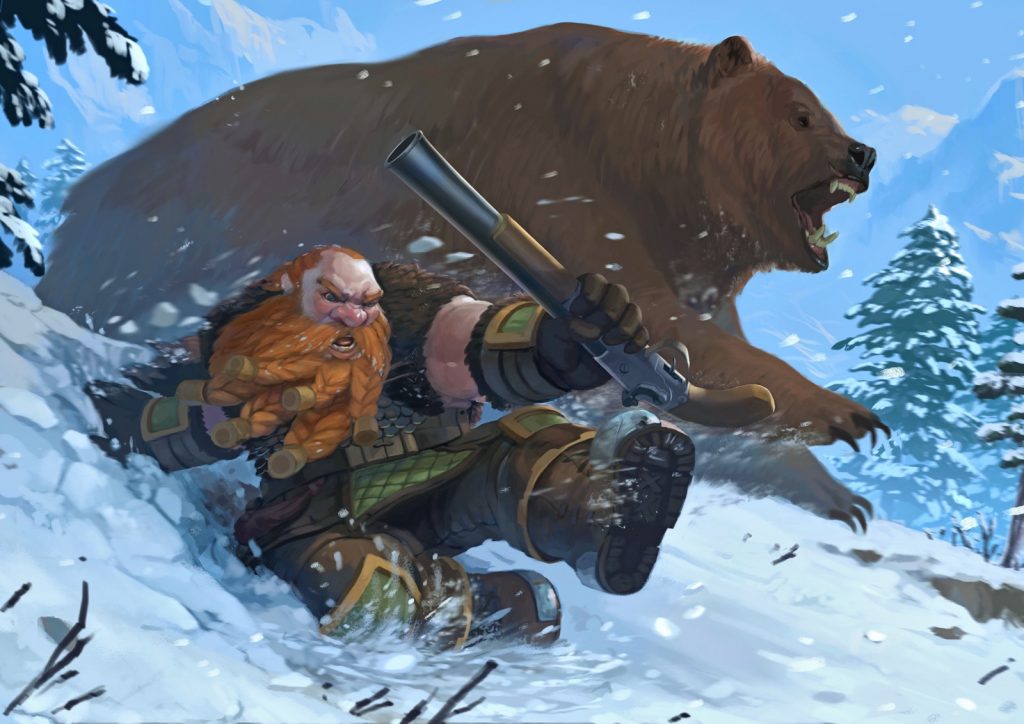Building Challenging Encounters

Building encounters using CR has, for many, resulted in a disappointing unpredictability that makes what should be the standard method feel unusable. The CR system isn’t able to account for the effects of terrain, the synergy of abilities between various types of monsters, or the competency and capability of different groups of players. The designers admit that CR was never intended to be a guarantee and that it functions best when used as a quick method to see if an encounter might statistically be too tough for a group of players.
Sometimes players want a cake walk. If they struggled at first level to clear a cavern of kobolds, it could help illustrate how their strength has grown when they meet another band of kobolds several levels further into their story and chew through them with ease. This tactic works best when used infrequently and on purpose, but what happens if you find that every combat you build by the book is too easy?

Image source: Complady @ pixabay
Summon the Horde!
Increasing the number of monsters in an encounter sounds like an obvious way of ramping up the difficulty in a fight. But in practice, there’s more than one way to go about doing this. If you’re in the middle of an encounter and find that the players are striking down enemies too quickly, bringing in reinforcements helps bolster the numbers and raise the challenge. One or more of the monsters in the fight might run for help. Creatures behind the next door might hear the commotion and come to investigate. There could be alarm bells or spells that alert others to the presence of the party. Using these tricks is the easiest way to scale up the difficulty of your encounters on the fly, so being aware that this is a tactic you might need to use and ensuring that you are creating scenarios where it makes sense for reinforcements to join can help you immeasurably with your adventure design.
You can also use loads of low-CR monsters in your initial design for an encounter. Some methods of encounter building that utilize CR calculations discount monsters that are significantly below the party’s level to the point where it can be a challenge to decide how to incorporate them. They also tend to have attack bonuses that make them statistically unlikely to be much of a threat to the players. The guidelines for handling mobs on page 250 of the Dungeon Master’s Guide circumvents both of these concerns, providing the number of low-CR monsters required to ensure that one of them hits the player characters.
Stop the Ritual!
The Dungeon Master’s Guide calls this an encounter objective and provides some helpful examples on page 81. The basic idea is to give the players a task that they need to complete in the middle of combat. Even if they reduce all of the monsters to 0 hit points, they might still fail if they cannot achieve their task. The most suspenseful tasks will be time sensitive – rescuing a captive being lowered into a river of lava, stopping the cultists from summoning the demon lord or escaping a flooding corridor. The monsters in an encounter like this are a distraction so they need not be threatening on their own. The difficulty comes in choosing between trying to ignore them to complete the objective or attempting to quickly lay them to waste to clear the way to their target.

Image produced by Conceptopolis. © 2018 Blizzard Entertainment
Capture the High Ground!
Use terrain and location to make things interesting. Murder holes, archers on watchtowers or across rivers, crumbling bridges, and hidden traps all can significantly hamper the advancement of characters. While a fighter climbs the ladder to the top of the watchtower, kobold archers are firing down upon her. Those monsters now have a round or two where they are out of reach of part or all of the players and able to threaten them without fear of immediate reprisal. The terrain itself might be hazardous – collapsing ceilings or volcanic eruptions could jeopardize the players. The Dungeon Master’s Guide has guidelines on page 249 for improvising damage in situations like these, but their most important aspect is that they cannot be directly removed from the encounter in the way that monsters can.
Pull the Plug!
If you build an encounter filled with monsters and traps and the players quickly remove most of these obstacles by the middle of the second round and are not enjoying their progress, come up with a creative way to end the encounter early – don’t waste your time with easy encounters if they aren’t fun! Monsters can surrender or flee. Running away can let them join up with other groups lurking in your dungeon, helping you beef up those encounters. The players can coax monsters into revealing compromising intelligence about their goals, secret passages, or the terrors that await deeper within their stronghold. Sometimes playing the game of attrition isn’t fulfilling, so never hesitate to wrap things up quickly to move on to something more fulfilling.
Many of these methods can be combined and things like traps can fall into more than one category – reaching a golden chalice on a sinking pedestal at the end of a long corridor filled with multiple traps could fulfill the design parameters of mobs, objectives, and terrain all in a single encounter. Still, even the best-laid plans won’t always work the way you intend. There’s just enough luck and skill involved on the part of the players that sometimes things will inevitably fall apart, but being aware and prepared with these options can go a long way towards helping you recover an encounter from abject failure.

David Adams
Part-time freelancer, full-time wizard. Works for coin or spell scrolls.
David Adams has been pestering Dungeons and Dragons publishers for the past 12 years and managed to collect a myriad of credits in that time. He has had the good fortune of seeing his content published by the likes of Kobold Press and Wizards of the Coast in addition to other recognizable companies.
David started playing D&D when he was 16 and the game has been an amazing outlet for creativity as well as a fascinating space to explore complex social issues while simultaneously slaying dragons in epic combat. The ability of the game, regardless of edition, to transmute his interests into exciting experiences he can share with friends is the key aspect that keeps his interests fixed upon it.
Building Challenging Encounters

Building encounters using CR has, for many, resulted in a disappointing unpredictability that makes what should be the standard method feel unusable. The CR system isn’t able to account for the effects of terrain, the synergy of abilities between various types of monsters, or the competency and capability of different groups of players. The designers admit that CR was never intended to be a guarantee and that it functions best when used as a quick method to see if an encounter might statistically be too tough for a group of players.
Sometimes players want a cake walk. If they struggled at first level to clear a cavern of kobolds, it could help illustrate how their strength has grown when they meet another band of kobolds several levels further into their story and chew through them with ease. This tactic works best when used infrequently and on purpose, but what happens if you find that every combat you build by the book is too easy?

Image source: Complady @ pixabay
Summon the Horde!
Increasing the number of monsters in an encounter sounds like an obvious way of ramping up the difficulty in a fight. But in practice, there’s more than one way to go about doing this. If you’re in the middle of an encounter and find that the players are striking down enemies too quickly, bringing in reinforcements helps bolster the numbers and raise the challenge. One or more of the monsters in the fight might run for help. Creatures behind the next door might hear the commotion and come to investigate. There could be alarm bells or spells that alert others to the presence of the party. Using these tricks is the easiest way to scale up the difficulty of your encounters on the fly, so being aware that this is a tactic you might need to use and ensuring that you are creating scenarios where it makes sense for reinforcements to join can help you immeasurably with your adventure design.
You can also use loads of low-CR monsters in your initial design for an encounter. Some methods of encounter building that utilize CR calculations discount monsters that are significantly below the party’s level to the point where it can be a challenge to decide how to incorporate them. They also tend to have attack bonuses that make them statistically unlikely to be much of a threat to the players. The guidelines for handling mobs on page 250 of the Dungeon Master’s Guide circumvents both of these concerns, providing the number of low-CR monsters required to ensure that one of them hits the player characters.
Stop the Ritual!
The Dungeon Master’s Guide calls this an encounter objective and provides some helpful examples on page 81. The basic idea is to give the players a task that they need to complete in the middle of combat. Even if they reduce all of the monsters to 0 hit points, they might still fail if they cannot achieve their task. The most suspenseful tasks will be time sensitive – rescuing a captive being lowered into a river of lava, stopping the cultists from summoning the demon lord or escaping a flooding corridor. The monsters in an encounter like this are a distraction so they need not be threatening on their own. The difficulty comes in choosing between trying to ignore them to complete the objective or attempting to quickly lay them to waste to clear the way to their target.

Image produced by Conceptopolis. © 2018 Blizzard Entertainment
Capture the High Ground!
Use terrain and location to make things interesting. Murder holes, archers on watchtowers or across rivers, crumbling bridges, and hidden traps all can significantly hamper the advancement of characters. While a fighter climbs the ladder to the top of the watchtower, kobold archers are firing down upon her. Those monsters now have a round or two where they are out of reach of part or all of the players and able to threaten them without fear of immediate reprisal. The terrain itself might be hazardous – collapsing ceilings or volcanic eruptions could jeopardize the players. The Dungeon Master’s Guide has guidelines on page 249 for improvising damage in situations like these, but their most important aspect is that they cannot be directly removed from the encounter in the way that monsters can.
Pull the Plug!
If you build an encounter filled with monsters and traps and the players quickly remove most of these obstacles by the middle of the second round and are not enjoying their progress, come up with a creative way to end the encounter early – don’t waste your time with easy encounters if they aren’t fun! Monsters can surrender or flee. Running away can let them join up with other groups lurking in your dungeon, helping you beef up those encounters. The players can coax monsters into revealing compromising intelligence about their goals, secret passages, or the terrors that await deeper within their stronghold. Sometimes playing the game of attrition isn’t fulfilling, so never hesitate to wrap things up quickly to move on to something more fulfilling.
Many of these methods can be combined and things like traps can fall into more than one category – reaching a golden chalice on a sinking pedestal at the end of a long corridor filled with multiple traps could fulfill the design parameters of mobs, objectives, and terrain all in a single encounter. Still, even the best-laid plans won’t always work the way you intend. There’s just enough luck and skill involved on the part of the players that sometimes things will inevitably fall apart, but being aware and prepared with these options can go a long way towards helping you recover an encounter from abject failure.

David Adams
Part-time freelancer, full-time wizard. Works for coin or spell scrolls.
David Adams has been pestering Dungeons and Dragons publishers for the past 12 years and managed to collect a myriad of credits in that time. He has had the good fortune of seeing his content published by the likes of Kobold Press and Wizards of the Coast in addition to other recognizable companies.
David started playing D&D when he was 16 and the game has been an amazing outlet for creativity as well as a fascinating space to explore complex social issues while simultaneously slaying dragons in epic combat. The ability of the game, regardless of edition, to transmute his interests into exciting experiences he can share with friends is the key aspect that keeps his interests fixed upon it.

0 Comments